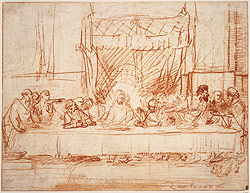Difference between revisions of "Rembrandt"
m |
|||
| Line 1: | Line 1: | ||
[[Image:Rembrandt Self Portrait.jpg|left|Self Portrait]] | [[Image:Rembrandt Self Portrait.jpg|left|Self Portrait]] | ||
'''Rembrandt''' (full name ''Rembrandt Harmenszoon van Rijn'') (Leiden 1606 - Amsterdam 1669), was the most acclaimed painter in the [[Netherlands]]—the greatest of the "Dutch Masters." He considered himself a religious painter, but he is most famous for his [[portraits]]. Rembrandt produced about 600 paintings including his 50-60 self portraits, he made 300 etchings, and an estimated number of about 1,400 drawings. Most of his drawings look unfinished, but he stated a drawing is finished when the artist has fulfilled his intentions. Some of his most famous paintings are: Jewish Bride (1632), Nightwatch (1642), The Syndics of The Cloth Guild (1661), Bathsheba (1654), Jacob Blessing the Sons of Joseph (1656), and a Self Portrait (1669). | '''Rembrandt''' (full name ''Rembrandt Harmenszoon van Rijn'') (Leiden 1606 - Amsterdam 1669), was the most acclaimed painter in the [[Netherlands]]—the greatest of the "Dutch Masters." He considered himself a religious painter, but he is most famous for his [[portraits]]. Rembrandt produced about 600 paintings including his 50-60 self portraits, he made 300 etchings, and an estimated number of about 1,400 drawings. Most of his drawings look unfinished, but he stated a drawing is finished when the artist has fulfilled his intentions. Some of his most famous paintings are: Jewish Bride (1632), Nightwatch (1642), The Syndics of The Cloth Guild (1661), Bathsheba (1654), Jacob Blessing the Sons of Joseph (1656), and a Self Portrait (1669). | ||
| â | |||
| â | |||
Rembrandt's paintings are known for their depiction of light and shadow. The increasing number of portraits by Rembrandt and others demonstrated the new emphasis on [[individualism]] in the Renaissance. | Rembrandt's paintings are known for their depiction of light and shadow. The increasing number of portraits by Rembrandt and others demonstrated the new emphasis on [[individualism]] in the Renaissance. | ||
| â | + | [[Image:Rembrandt The Last Supper, after Leonardo da Vinci.jpg|thumb|right|This red-chalk drawing by Rembrandt is closely based on an early print after Leonardo da Vinci's famous mural of the Last Supper]] | |
''Of all the Baroque masters, it was Rembrandt who evolved the most revolutionary technique and who seemed to grow into the Italians' spiritual heir.''<ref> [http://www.artchive.com/artchive/R/rembrandt.html Rembrandt] The ARTCHIVE. </ref> | ''Of all the Baroque masters, it was Rembrandt who evolved the most revolutionary technique and who seemed to grow into the Italians' spiritual heir.''<ref> [http://www.artchive.com/artchive/R/rembrandt.html Rembrandt] The ARTCHIVE. </ref> | ||
<br><br> | <br><br> | ||
| â | + | :::[[Image:Rembrandt Portrait of Gerard de Lairesse.jpg|90px|Portrait of Gerard de Lairesse]] | |
| + | |||
<blockquote style="background: #F9F9F9; border: 1px solid #AAAAAA; padding: .3em;"> | <blockquote style="background: #F9F9F9; border: 1px solid #AAAAAA; padding: .3em;"> | ||
Revision as of 11:28, September 20, 2008
Rembrandt (full name Rembrandt Harmenszoon van Rijn) (Leiden 1606 - Amsterdam 1669), was the most acclaimed painter in the Netherlands—the greatest of the "Dutch Masters." He considered himself a religious painter, but he is most famous for his portraits. Rembrandt produced about 600 paintings including his 50-60 self portraits, he made 300 etchings, and an estimated number of about 1,400 drawings. Most of his drawings look unfinished, but he stated a drawing is finished when the artist has fulfilled his intentions. Some of his most famous paintings are: Jewish Bride (1632), Nightwatch (1642), The Syndics of The Cloth Guild (1661), Bathsheba (1654), Jacob Blessing the Sons of Joseph (1656), and a Self Portrait (1669).
Rembrandt's paintings are known for their depiction of light and shadow. The increasing number of portraits by Rembrandt and others demonstrated the new emphasis on individualism in the Renaissance.
Of all the Baroque masters, it was Rembrandt who evolved the most revolutionary technique and who seemed to grow into the Italians' spiritual heir.[1]
The Netherlands of the 17th century saw an extraordinary growth of artistic achievement, accompanied by great prosperity. Painters such as Rembrandt, Vermeer, Hals, De Hooch, and Ruisdael began to specialize in portraiture, landscape, still life, and genre painting. The Metropolitan Museum of Art, New York.
See also
- Painting Schools
- Painting Masterpieces PART II
- Gallery of Flemish and Dutch painting
- Flemish School of Painting
External links
- The Night Watch, Rembrandt's most famous painting
- Supper at Emmaus, one of his religious paintings.
- Rembrandt
References
"Nightwatch"




